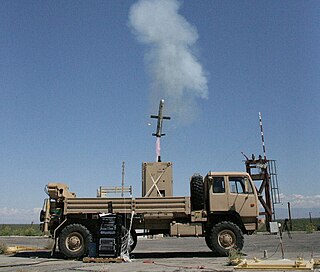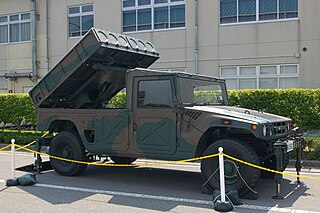
The Dongfeng series, typically abbreviated as "DF missiles", are a family of short, medium, intermediate-range and intercontinental ballistic missiles operated by the Chinese People's Liberation Army Rocket Force.

The Rafael Python (פיתון) is a family of air-to-air missiles (AAMs) built by the Israeli weapons manufacturer Rafael Advanced Defense Systems, formerly RAFAEL Armament Development Authority. Originally starting with the Shafrir series, the Shafrir-1 missile was developed in 1959, followed by the Shafrir-2 in early 1970s. Subsequently, the missiles were given the western name of "Python" by the parent company for export purposes, starting with the Python-3 in 1978. Since then, it has been further developed and evolved into the Python-4, Python-5, Derby and also, the SPYDER, an advanced ground-based air-defence system. Currently, the missiles are in service with the armed forces of over fifteen countries from around the world.

The Polyphem was a proposed European light-weight fibre-optic wire-guided surface-to-surface missile with a range of 60 km. The project was cancelled in 2003.

The 9M123 Khrizantema is a Russian anti-tank guided missile (ATGM). Khrizantema was designed to deal with current and future generations of main battle tanks and can also be used to engage slow and low flying aerial targets like helicopters. The 9M123 missile, and its associated guidance system, forms the 9K123 missile system.

The 9K121 Vikhr is a Soviet laser-beam-riding anti-tank missile. "9K121" is the GRAU designation for the missile system. The missile can be launched from warships, Ka-50 and Ka-52 helicopters, and Su-25T aircraft. It was first shown publicly at the 1992 Farnborough Airshow.

The Non-Line of Sight Launch System (NLOS-LS) was a self-contained missile launcher system that was under development by NETFIRES LLC, a partnership between Lockheed Martin and Raytheon. Each Container Launch Unit (CLU) holds 15 missiles, and a self-locating networked communications system. CLUs can be linked for coordinated launching, with the missiles fired and controlled remotely via autonomous vertical launch. The weapon is roughly 2 metres tall.

The Weishi family of multiple rocket launcher systems were mainly developed by Sichuan Academy of Aerospace Technology in the central province of Sichuan, China at Chengdu city. The systems include the 302 mm (11.9 in) WS-1, the improved 302 mm (11.9 in) WS-1B, the 122 mm (4.8 in) WS-1E, the 400 mm (16 in) WS-2, as well as many other models. The WS-1 series weapon system did not enter PLA service and has order from Thailand. The WS-2 may finally see PLA service in the future. It's worth noticing that although sharing the same name, there are other developers for different models of Weishi series multiple rocket launchers (MRL) other than the primary developer SCAIC.

The C-704 is a Chinese anti-ship missile. The missile was developed by the third research institute of the Chinese Aerospace Group, also the manufacturer of the C-701.
The TL-6 or Sky Dragon - 6 is a light anti-ship missile.
The TL-10 or Sky Dragon (天龙) - 10 is a light anti-ship missile unveiled in the Zhuhai Airshow in 2004 in China, and it is the Chinese equivalent of the French MM-15TT / AS-15TT light anti-ship missile developed by Aérospatiale.
TY-90 is a Chinese air-to-air missile specifically developed for attack helicopter dogfights. Contrary to erroneous claims, the missile is not developed from MANPADS missiles, but instead, it is specifically designed as an air-to-air missile to engage in helicopter combat.

The Nimrod is a long-range air-to-surface missile developed by Israel Aerospace Industries. While designed for mainly anti-tank warfare, it provides standoff strike ability against a variety of point targets such as armoured personnel carriers (APCs), ships, bunkers, personnel concentrations, and guerrillas.
The A-100 is a 300 mm (12 in), 10-tube multiple rocket launcher developed by Beijing-based China Academy of Launch Vehicle Technology for the Chinese PLA ground forces. It is a derivative of Weishi Rockets WS-1 with simple cascade terminal inertial guidance.

The Type 96 Multi-Purpose Missile System (96式多目的誘導弾システム) is an Anti-tank/Landing craft missile used by the JGSDF. It is the first Japanese missile system that uses a complete digitally controlled interface.
The B-611 is a Chinese solid-fuelled short-range ballistic missile (SRBM) developed by China Precision Machinery Import-Export Corporation (CPMIEC). The missile has a maximum range of 150–400 km (93–249 mi).

LS is an abbreviation for a family of Chinese built precision-guided munitions (PGM) named Thunder Stone Precision Guided Bomb developed by China Aerospace Science and Technology Corporation (CASC). Alternatively, the LS PGB is also referred to by its gliding capability, as Thunder Stone Gliding Guided Bomb, or LS GGB. The guidance design of LS PGB is also adopted for another family of Chinese PGM, the YZ series, such as YZ-102 series. These PGMs are referred to in China as precision guided bombs (PGB).
The HQ-17 is an all-weather, low to medium altitude, short-range surface-to-air missile system derived from the Tor-M1.

The Amogha-1 (Unfailing) is a second generation guided anti-tank missile with a range up to 2.8 km (1.7 mi). It is under development by Research and Development Division of Bharat Dynamics Limited at Hyderabad. It is the first missile designed and tested by Bharat Dynamics. The missile will be produced in two versions. The land version has already been tested. The infrared version of the missile uses a "thermal intelligent vision" to attack its target.
HQ-11, export designation FM-3000, is a mobile short-to-medium range combined air defense missile and gun system designed for terminal air defense. Designated as the "universal terminal defence system" in Zhuhai Airshow 2022, unveiled by China Aerospace Science and Industry Corporation (CASIC). The export version, FM-3000, was unveiled by CASIC in 2014.

The Chengdu Wing Loong-3 is a Medium-Altitude Long-Endurance (MALE) unmanned aerial combat vehicle (UCAV), developed by the Chengdu Aircraft Industry Group in the People's Republic of China. Intended for use as a multi-purpose platform, including anti-air, anti-submarine warfare (ASW), ground strike, maritime strike, search and rescue, and surveillance and aerial reconnaissance capabilities which can fly a maximum range of 10,000 km at medium altitude with a maximum take-off weight of 6,200 kg. Wing Loong-3 is by far the largest and first air-to-air capable model of the Wing Loong family













